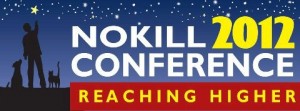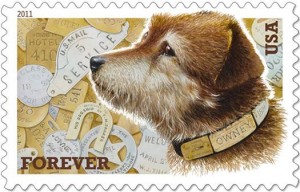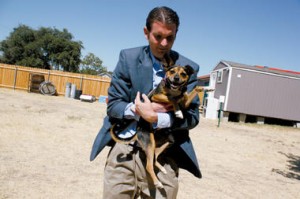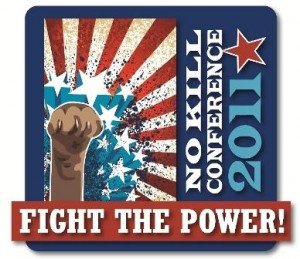Liveblogging No Kill Conference 2012: Advocacy Blogging
 Speaker John Sibley has been blogging since 2004, starting as a humor blogger, but his blogging has evolved into more writing and advocacy on behalf of New York animals. His writing was instrumental in killing the ‘Quick Kill’ Bill in New York.
Speaker John Sibley has been blogging since 2004, starting as a humor blogger, but his blogging has evolved into more writing and advocacy on behalf of New York animals. His writing was instrumental in killing the ‘Quick Kill’ Bill in New York.
First, tech stuff–Blogger (from Google) is quick and easy and you don’t need to know tech to use it. If you know something about HTML, self-hosting WordPress [this blog is self-hosted with WordPress] is a great way to go. It is versatile and powerful. Avoid Examiner.com, a blogging network disguised as a newspaper. I know others may disagree. Don’t take ads. You won’t make any money and some ad services will give you ads you don’t want, like puppy mills!
Content and style–write what you know best. Explain what you are an expert on and give it to someone with no knowledge of the subject and ask if they understand your point. Be clear and engaging.
Always be gathering new information. You must use Google Alerts! You can get a lot of info from watching Facebook, especially other advocates, and following up on it. RSS Readers draw together multiple blogs that you subscribe to. It is an old technology compared to FB, but very useful.
Be active in your chosen community, constantly on the search for new information. Attend meetings, lectures, protests. Personal contact means a lot! Use 3rd party sources when necessary (ie when shelters won’t let you in). make sure your readers can contact you directly–email, FB , twitter, etc. You will get spam. A different attitude to privacy. FB feed is public, but comments are restricted to those he knows due to time constraints.
FOIA requests: you have the right to view many government documents. Christie Keith and Yesbiscuit! know a lot about this subject.
Screenshots of important data that is likely to disappear. Collect puzzle pieces over time to make a complete picture. Rarely will you get something actionable all at once.
Calling someone out publicly depends on whether they are a public figure and the degree of their wrongdoing. Use personal ethical guidelines, and protect sources that do not want to be identified.
Blogging is not journalism! It has an overt opinion, it presents a point of view. It is dishonest to present opinion as fact.
Think about your style. The must-read Yesbiscuit! mixes news and sarcasm and does her own investigations (sometimes of distant shelters) using FOIA requests, emails and contacts with her dedicated fan base. Read what other people are writing–Christie Keith, this blog, Kathy Pobloskie, Brent Toellner (best at analyzing stats that we have).
Avoid common pitfalls:
“Spewing”/ constant negativity. Getting very emotional, can be a turn off for many, including me–show, don’t tell.
Don’t rely on shocking or very graphic photos or techniques. But before/after pics of Patrick are an example of effective pictures.
pay attention to grammar and spelling–use Word if necessary.
Avoid unnecessary detail. Only include details that further the story. Short and to the point.
Anonymity–you need people to trust you. This is hard if they don’t knwo who you are. Understandably, you may be afraid of losing access, but people cant build a relationship with you if they don’t know who you are.
If you have a blog and you are the head of a nonprofit, your blog will be associated with that organization. People should find out your associations from you or it will look like you are hiding something.
Check the bylaws. You can disclose your association in a disclaimer. If you are an employee of an organization, and you are writing about a topic related to what they do, you need to let them know. There should be a policy.
Know your target audience!
Posts should stand on their own and be free of excessive jargon. Include links to backstory, for further exploration.
Comment policy: if you are writing about controversial topics, you need to think about and possibly post a comments policy so that people know what is/is not appropriate. Personally I advocate an open but moderated discussion. You are not obligated to provide a forum for crazy. Know how to block people/IP addresses but don’t do it often.
Expect pressure–it is a sign of success. In 2009, HSUS tried to get me fired for a piece of commentary on a video that was unflattering to HSUS. They called my boss who told me to take the post down. Now I work in a different industry, HSUS could not exert that kind of influence. I didn’t take it down and kept my job. Today a similar incident would simply provide me with tons of material.
Get the word out. People need to find it to read it–use social media. FB is king. Also RSS, twitter. twitter attracts power users. Things can go viral very quickly on FB. FB great for reaching people directly.
PARTICIPATE in FB and twitter communities, not just for self-promotion. Be a regular part of the community. Submit your posts to No Kill Nation and No Kill Revolution. If they pick it up, you can get a lot of readers. Some posts have only local interest, though.
Many people are annoyed by email. Google+ has much lower traffic.
Christie Keith–we should all get G+ accounts and post to it at least one a month to keep it active. It improve Google ranking.
Are your posts FB friendly? You get a thumbnail, title, a couple of lines (unless mobile) and it must be compelling or it won’t get shared. You need to control your metadata.
Use pics as much as possible. When you publish your blog matters less than when you announce it on FB and twitter. 9am-6pm M-F is best for social media. If you publish at 3 am, announce during peak hours. Don’t announce on Sunday.
Make it easy for people to share your posts. Sociable makes plugins for sharing on social media.
Post titles–be the New York post, Not the Wall Street Journal.
Example–Anthony Weiner’s image rehab in People
WSJ: Weiner won’t rule out a run
NYP: Weiner shows off his little one
Other Networking:
Have a relationship with your readers, but also other writers/bloggers/power users. They can help you with stories, technical issues, sources, tips, etc. Read them, link to them, comment and participate. ALWAYS make time for reporters. Be a source. Give them independently verifiable data. Be a reliable source of information.
I have had 3 reporters come along on rescue pulls with me.
Case Studies:
1. Gloria and the ASPCA–story started with photo of cage card “Left at ASPCA Mobil clinic” Why was the wealthy ASPCA bringing animals to NYCACC? They are where lost animals are taken, but a welfare group should have a hard time taking animals there.
Wrote about Gloria and another cat Benny (rescued by ECC) posing question of why she was taken to ACC by ASPCA.. Thought that was the end. Then she was put on kill list. Sent to pull her. Cool to meet her. It was clear something was wrong with her, not just URI, really wrong with her.
X-Ray revealed severe leg fracture. ASPCA knew about this and brought her to NYCACC and told them about fracture. NYCACC did nothing in 3 weeks. 2 medical exams failed to note the fracture. The break was a month old. We had the records to prove it. Continued to write about the case as it unfolded (with permission of Pets Alive, the rescue he pulled her for).
Usually the ASPCA ignores you and never apologizes. Kerry Clair of Pets Alive called her contacts in ASPCA. They were horrified. Uncharacteristically, the ASPCA quickly apologized and said they’d reexamine their policy.
Gloria had to have the leg amputated and was adopted by a friend.
If the ASPCA would apologize and fix things more often, they would get more respect.
Key factors:
- rock solid information
- great pictures
- the involvement of the ASPCA, publicly documenting what local rescuers already know
2. NYCACC New Computer Rescue System–costly and flawed, leading to animal deaths
An example of needing to protect source–redacted identifying info from screenshots supplied by NYCACC employee
Screenshots showed failure of the system. Picked up by the NY Post and Daily Mail, which needed photos of the animals in question in 45 minutes. Also News 4. A very successful story.
NY has been very dysfunctional for a very long time. Reporters and editors feel the story has been done to death.
This story started with a reader tip, then the employy sent 15 screenshots.
3. Killing the Quick Kill Bill
The ASPCA’s attempt to derail shelter access law in NY
Who reads legislation?
2/10/12 Nathan published a piece detailing the A’s plan to introduce a trojan horse bill in partnership with the Mayor’s Alliance and the Animal Law Coalition
2/11/12 The Quick Kill Bill, promoted by Amy “Quick Kill” Bill is born, complete with cheeky graphic after the Kill Bill movie poster–went viral quickly.
Her FB page was innundated with opposition. 2000:1 opposed. She dug in her heels and would not respond to reason.
Mounted campaign. Loosely organized coalition of people doing their own thing–no one was particularly in charge. There were online and offline components.
In Dog We Trust served as info clearinghouse. Nathan took out newspaper ads which got a huge response. A sticker ended up on Paulin’s office door (with photographic documentation).
Sent postcard mailers to all of her constituents in wealthy Scarsdale–targeting her financial base. This got a big reaction. Cost of postcards $2200. Raised money quickly online.
This was a great example of changing the terms of the debate–reporters, legislators and staff referred to it as the Quick Kill Bill.
Petitions are often useless. People often not targeted correctly. Easy to ignore. Best way to stop something is to flood their office with angry phone calls–must be overwhelming.
Nathan wrote a post about Paulin’s love of pen certificates, urging readers to send her a pen.
Got custom syringe pens with her name on them, and gave them out at an adoption event in her district. She came to the event in an effort to rehab her image.
Met with Kerry Clair and dropped the bill.
Key factors:
- grassroots faster and more agile than big orgs, know right from wrong,
- legwork–scouring NYS Assembly site for updates,
- crossover to mass media
- persistence
- branding, repetition, good visuals
Contact info: John Sibley
john@johnsibley.com
twitter: @jbsibley











